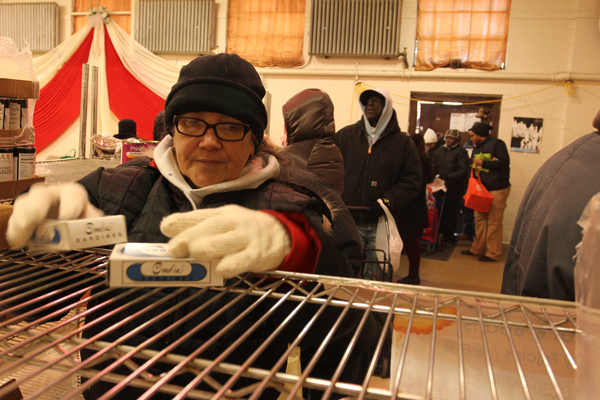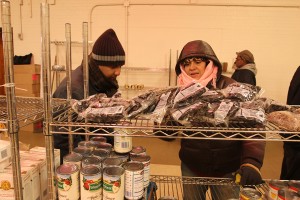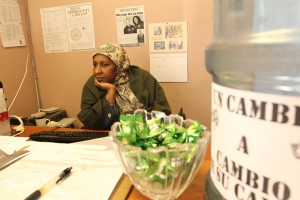By Mustafa Mehdi Vural and Jose Leyva

The Riveras share their 18th floor apartment with three chihuahuas, birds and a small aquarium. Photo By Mustafa Mehdi Vural
The elevators break down at least twice a month in the Murphy Houses, a 20-story, low-income complex at 1805 Crotona Ave. in the Bronx.
Disrupted service is an inconvenience for all its 714 residents. But a broken elevator poses an extra burden for Francisco Rivera, 31, from Puerto Rico, who lives on the 18th floor with his wife and two children.
Francisco Rivera’s right leg was amputated 13 years ago when doctors found a cancerous tumor on his knee in Puerto Rico. At that time, Rivera was an 18-year-old boxer in high school, and also a husband and father of one daughter.
Doctors at Jacobi Hospital in the Bronx found and removed another tumor in his brain last May, bringing his total number of tumors to 18. After numerous operations, he has lost half of his right lung and part of his groin.
“There are no hospitals in Puerto Rico like in the U.S., there is no such technology,” said Rivera’s 29-year-old wife, Elizabeth, in Spanish. She was 13 when she met Francisco and 15 when she first gave birth to their daughter, Franshely.
“Doctors told me that I had a year to live,” said Rivera recounting their ordeal in Puerto Rico. His cane leaned against the couch. And the walls in the living room were covered with the Puerto Rican flag.
The Rivera family immigrated to the United States in 2000 in search of better medical treatment.

"I am a fighter, I have always been fighting for my life and for my family's well being," said Francisco Rivera. Photo By Mustafa Mehdi Vural
“The doctors say I am a miracle,” said Rivera. “I tell my husband you’re a living miracle, because I’ve seen cases like yours and they just don’t make it,” said Elizabeth.
Francisco survived brain surgery in May, but it has left his vision impaired in his left eye, and visible scars in his skull, which was reconstructed with metal implants.
“I have small memory problems. Right now I’m taking pills to prevent epilepsy,” said Rivera.
On a Monday afternoon in late October, the elevator was out of service again in the Murphy Houses. So the Rivera family had to make it down the stairs to go to Old Navy department store in Co-op City, in the Bronx.
They were not going shopping. They were going to collect a $1,000 gift, along with new clothes as part of Old Navy’s nation-wide project called “One in a Million.”
“It is inspiring to know that such a huge fashion store is interested in helping people like us,” said Rivera. “I think they are recognizing my own efforts to overcome the cancer.”
This project is meant for each store manager to invest $1,000 in his or her community. The company reserved $1 million in total for this nationwide project that hopes to reach out to 1,000 families in need.
“Anything that they can get is a help during this tough economy,” said Jenira Lopez, the store manager of Old Navy in Coop City.
Early in October, Lopez reached out to Ivine Galarza, the District Manager of the Community Board 6, to identify a needy family in East Tremont.
She had many residents to choose from.
More than 40,000 people receive public assistance in East Tremont, which comes to over 50 percent of the population. In the Bronx, overall, 41 percent of the population is on welfare, 10 points more than the citywide average, according to 2008 district profile data.
“Anyone of these families would have been candidate for this award that Francisco Rivera got,” said Galarza.
“I immediately thought of him,” said Galarza. “I know of him and of his family and of his conditions for years. The situation that they are going through is terrible.”
Galarza noted that the city does not do enough to take care of the poor in her district.
“This is unrealistic–$4 a day for a person to have lunch,” said Galarza, pointing to the figure in the official city document called “Guide to Cash Assistance Budgeting.” “At least in this holiday season, we are making one family happy out of 175,000 families that live in the confines of the Community Board 6.”
The Rivera family’s yearly income is approximately $20,400 a year, $1,000 below the poverty line for a family of four. The average household income in the Bronx is $34,031 compared to $53,448 citywide.

The Riveras have been married for 16 years and have spent 13 of those in hospitals. Photo By Mustafa Mehdi Vural
Francisco’s wife is the family’s main income provider. She works 30 hours a week as home health care attendant for Gotham Per Diem. “I take care of patients with cancer,” said Elizabeth. She earns $9 per hour, providing 60 percent of the family’s income – almost $1,000 a month. The rest comes from the Supplemental Security Income, a federal welfare program for disabled people.
“I just can’t work. It wasn’t a decision I made,” said Rivera. He spends half of his time at home and the other half in the hospital. “I cook, clean the house and take care of our kids.”
It is not easy for Francisco Rivera to execute his daily routine tasks without taking a morphine derivative to fight pain.
Nor is it easy to make ends meet.
The Riveras pay $510 a month for a two-bedroom apartment, which means that each of the family members live on approximately $10 a day.
Elizabeth and Francisco know how to be economical and can now pay their bills without problem. But they realize their family’s expenses will increase as the kids grow up.
Franshely Rivera, 14, is a 9th grader in Wings Academy in the Bronx. She is also taking ballet classes. Miguel Rivera, 10, is a 5th grader in CS 92 and he plays Little League baseball in “Caribe Little League,” the biggest league for the kids in the Bronx.
But difficulties over the years have not kept the Riveras away from making long-term plans for the future.
“The only thing I want, I dream of, is that my children finish undergraduate school and raise a family if they want,” said Rivera.
College tuition will be difficult to manage. “We are going to save for the kids’ education,” said Rivera about the $1,000 gift from Old Navy.
Miguel, however, would prefer a plasma TV and Nintendo Wii, the latest model video game.
“My children are respectful, obedient and studious,” said Rivera. He loves to spend time with his kids, who takes Miguel to baseball practice and to school. He even taught his son how to ride a bike with his amputated leg.
“In the next three years I would like to take my family to Puerto Rico, I want my children to know their country and to meet our family,” said Rivera.
Though Francisco has spent his entire adult life in hospitals, it is not a cause for disappointment for him. He said he sees hope in operation rooms, consultations, and the pills that he takes.
“I am still alive, thank God. He has given me the strength to go forward and fight for my family which I adore,” said Rivera.
“I haven’t surrendered.”





